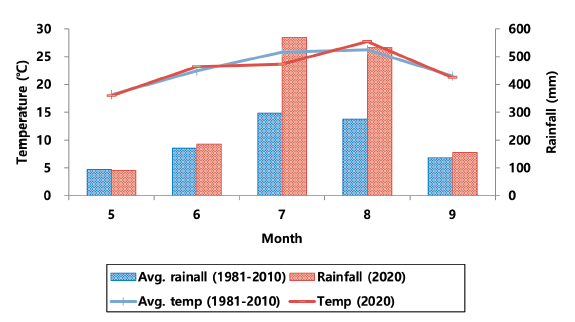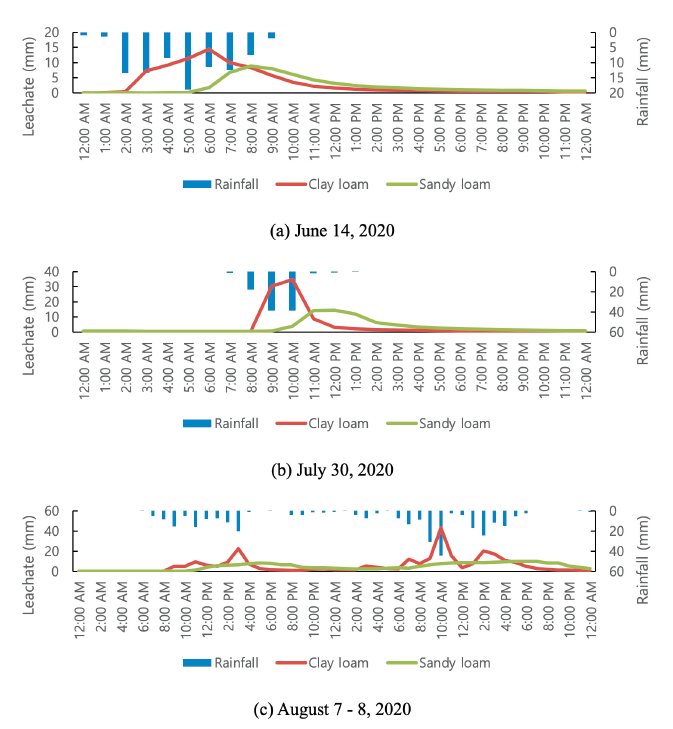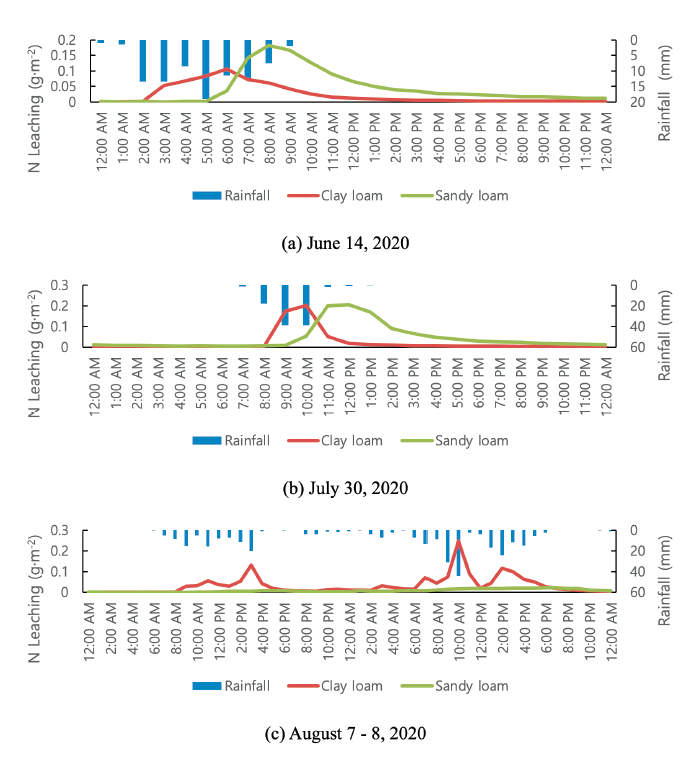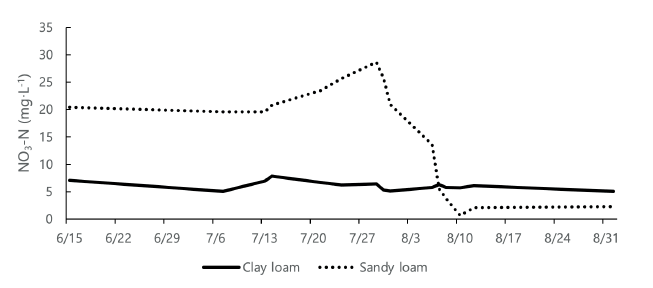Introduction
질소는 작물 생장에 필수적이며 가장 많은 양이 요구되는 원소로, 질소질 비료의 사용은 지난 몇 세기 동안 세계의 농업 생산량의 증대를 가능하게 했다(Crawford, 1995; Di and Cameron, 2002; Samborski et al., 2009). 그러나 농업에서 과다한 질소 비료의 사용은 비료 성분의 유출로 인해 질산태 질소가 주변의 하천이나 지하수로 유입될 수 있으며(Samborski et al., 2009; Padilla et al., 2018), 음용수의 질산태 질소 농도가 높을 경우 사람과 가축의 건강에 악영향을 끼치고 청색증을 유발할 수 있다(Di and Cameron, 2002). 질소 관리의 목표는 이러한 환경으로의 질소 유출을 감축하는 데에 있으며(Schmidt et al., 2009), 이를 위해서는 토양 내 질소 이동 양상을 분석할 필요가 있다.
농경지에서 질소 용탈량을 정량적으로 평가하기 위해서는 지표 유출량과 지하 유출량을 계측할 수 있는 장비가 필요하다. 라이시미터는 실제 재배환경에서 토양 중 물과 양분의 이동을 측정할 수 있는 장비로서(Winton and Weber, 1996), 농업 선진국에서는 양분 용탈량을 평가하는데 라이시미터를 많이 활용하고 있다. 영국에서는 1988 - 1995년 동안 기후 조건에 따른 양분 용탈량을 평가하였다(Shepherd and Bennett, 1998). 미국에서는 동계 피복작물 재배 시 질산태 질소 용탈을 평가하였고(Meisinger and Ricigliano, 2017), 스웨덴에서는 7년간 가축분 퇴비와 비료 사용에 따른 N, P, K 용탈을 분석하였다(Ulén, 1999).
토양의 양분은 물과 함께 이동하기 때문에 수분 이동과 양분 유출을 함께 평가해야 한다. 토양내 수분의 수직 이동은 토양의 물리적 구조에 영향을 받기 때문에 교란되지 않은 상태의 토양을 이용하면 자연상태에서의 수분 이동을 보다 정밀하게 연구할 수 있다(Seo et al., 2016). 이를 위하여 국립농업과학원에서는 2013년에 농경지 토양의 물리적 구조를 그대로 유지한 상태로 양·수분 이동 계측이 가능한 비교란 중량식 라이시미터를 도입하였으며, 2015년부터 현재까지 밭토양의 양·수분 유출량을 모니터링하고 있다. 봄배추 및 가을배추 재배시 토성별 물수지 비교(Ok et al., 2018; 2019), 배추와 옥수수 재배시 물관리 방법에 따른 물수지 비교(Ok et al., 2020), 물관리 방법에 따른 양분 용탈 및 콩의 양분 흡수 평가(Lee et al., 2017), 배추 재배에 따른 질소 수지 분석(Lee et al., 2018), 라이시미터 실측값의 APEX 모델 적용(Lee et al., 2020) 등의 연구 결과를 통하여 중량식 라이시미터가 밭토양의 수분 및 양분 이동을 정량적으로 나타낼 수 있음을 밝혔다.
본 연구에서는 강우에 의한 지하침출수와 질소 용탈이 토양의 물리성 차이에 따라 다르게 나타나는지 확인하기 위하여 국립농업과학원의 비교란 중량식 라이시미터를 이용하여 토양에 따른 수분의 침출 양상과 그에 따른 질소 유출량을 비교 분석하였다.
Materials and Methods
중량식 라이시미터
본 실험은 전라북도 완주군 이서면의 국립농업과학원 토양수분이동실험동(위도 35°49′29″, 경도 127°02′46″)에 설치된 비교란 중량식 라이시미터(UGT, Müncheberg, Germany)를 이용하여 수행되었다. 라이시미터는 깊이 1.5 m, 면적 1.0 m2인 스테인레스 재질의 원통이며, 실시간으로 측정되는 무게를 이용하여 환경 중 수분 이동을 판단할 수 있다. 지표면으로부터 10, 30, 55, 85, 125 cm 깊이에 토양 온도, 수분 측정 센서(UMP-1, UGT, Müncheberg, Germany), 토양용액 채취기(Suction probe system, UGT, Müncheberg, Germany)가 존재하며, 토심 1.5 m 아래로 배수되는 침출수량을 측정하는 Tipping counter가 설치되어 있다.
시험 토양 및 처리내용
시험 토양의 토성은 식양토(송정통)와 사양토(상주통)으로 2종류이며, 2013년에 토양의 물리성을 그대로 유지하도록 코어로 채취하였다. 해당 토양의 이화학적 특성은 Lee 등(2018)과 같다. 송정통은 토심 60 cm까지 점토 함량이 34% 이상인 토양이며, 상주통은 표토와 심토의 점토함량이 10% 이하인 토양이었다. 본 시험에 사용한 라이시미터는 현장의 토양 그대로 채취한 비교란 라이시미터이기 때문에 채취한 지점에 따라 라이시미터 셀 별 토양 구조의 차이가 있으며, 반복구를 설치하는데 시간 및 비용 소모가 많아 대표적인 셀을 선택하여 반복없이 비교하였다.
참깨(품종: 건백)는 2020년 5월 25일 1.0 m2에 6주를 정식하여, 2020년 8월 24일에 수확하였다. 비료 사용량은 작물별 비료사용처방 기준에 준하여 N-P2O5-K2O = 2.9-3.1-3.2 kg·10 a-1에 해당하는 양의 요소, 용성인비, 염화칼리를 전량 밑거름으로 시용하였다. 참깨 정식 전 토양 화학성은 Table 1과 같다.
Table 1. Chemical properties of experimental soils.
|
EC, electrical conductivity; OM, organic matter; T-N, total nitrogen; Av. P2O5, available phosphate; Exch. cations, exchangeable cations. |
재배 기간 중 기상 조건
기상은 국립농업과학원 중량식 라이시미터 인근에 설치한 자동 기상 관측 시스템을 이용하여 측정하였다. 2020년도 참깨 재배기간 중 총 강우량은 1,238.5 mm였다. 2020년 7월과 8월의 강우량은 각각 569.5, 533.5 mm로 평년 대비 각각 192, 194%로 많은 강우가 있었다(Fig. 1).
토양 이화학성 및 침출수 분석
토양 분석은 토양 및 식물체 분석법(NIAST, 2000)에 준하여 진행되었다. 토양 pH와 EC는 토양과 증류수를 1 : 5의 비율로 측정하였으며, 토양 유기물은 Tyurin 법, 유효인산은 Lancaster 법, 치환성 양이온은 1 M NH4OAC (pH 7.0)로 추출하여 유도결합플라즈마 분광 광도계(ICP-OES, GBC, Integra XL Dual, Braeside, Australia)로 분석하였다. 침출수의 질산태 질소, 암모늄태 질소는 이온 자동분석기(QuAAtro, Seal analytical, Mequon, WI, USA)로 측정하였다. 질소 유출량은 토심 1.5 m 아래로 유출되는 물량에 질산태 질소와 암모늄태 질소의 농도를 곱하여 합한 값으로 산정하였다.
통계처리
참깨 수량 및 등숙률의 토양 간 비교는 Excel 통계프로그램을 이용하여 Student t-test를 수행하고 통계적 유의성을 확인하였다. 이때 p-value가 0.05보다 작은 경우를 유의한 것으로 정의하였다.
Results and Discussion
수확기 참깨 수량
참깨 한 주 당 평균 종자 수확량은 식양토에서 11.1 g, 사양토에서 10.0 g였으며, 지상부의 건중은 각각 69.6, 63.6 kg·10 a-1이었으며, 통계적으로 차이는 없었다. 또한 종자 100개의 낟알의 무게인 백립중은 두 토양 모두 0.2 g, 종자의 등숙률은 식양토와 사양토 각각 84.2, 87.5%로, 두 항목 모두 유의적인 차이가 없었다(Table 2).
Table 2. Dry weight and yield of sesame in the harvest season.
|
ns, not significantly different. (Student t-test, p < 0.05). |
토성에 따른 지하 침출수량 차이
참깨의 개화기였던 7월 중순부터 8월 초의 지속적인 강우로 인해 식양토와 사양토의 지하 배수량은 7월 14일부터 8월 10일까지 각각 573.4, 563.8 mm으로 가장 많았다(Table 3). 식양토와 사양토의 작물 생육시기별 침출수량을 비교해보면 성숙기(8.11 - 8.23)를 제외하고 유묘기부터 개화 최성기까지 식질 토양에서 침출수량이 많았다. 강우 발생 후에 시간당 지하 침출수량은 식양토와 사양토에 따라 차이가 있었다(Fig. 2). 6월 14일 강우가 시작됨에 따라 식양토에서는 빠르게 침출이 일어나 오전 6시에 시간당 침출수량 최대치를 나타낸 반면(Fig. 3a), 사양토는 오전 8시에 최대치를 보여 식양토에 비해 상대적으로 침출속도가 느렸다. 7월 30일에는 시간당 40 mm의 강우가 두시간에 걸쳐 내렸고, 이에 따라 식양토는 오전 10시, 사양토는 12시에 가장 침출수량이 많았다(Fig. 3b). 8월 7일에서 8월 8일까지 있었던 강우에서도 앞의 두 일자와 마찬가지로 식양토에서 강우 시작에 따라 바로 지하 침출수가 발생한 반면, 사양토에서는 원만하게 지하 침출수량이 발생했다(Fig. 3c).
점토 함량이 높고 소성 지수가 높은 토양은 건조 시 부피 수축이 큰 경향이 있으며(Albrecht and Benson, 2001), 무경운 토양과 같은 대공극이 많은 경우 빗물의 침투를 강화하는 결과를 보였다(Elliott and Coleman, 1988). 따라서 식양토에서의 침출수량이 사양토에 비하여 많은 경향은 점토 함량이 높은 식질 토양의 경우 점토 입자의 팽창과 수축으로 형성된 대공극(Keith and Germann, 1982)을 통하여 투수가 이루어진 결과로 생각되며, 앞선 중량식 라이시미터를 이용한 물 수지 연구의 결과와 일치한다(Ok et al., 2018; 2019).
토성에 따른 질소 지하유출량 차이
참깨 재배기간 중 질산태질소의 지하 유출량은 식양토와 사양토 각각 5.42, 10.49 kg·10 a-1로 차이를 보였다. 사양토의 질소 유출량은 유묘기에 1.80 kg·10 a-1, 개화기에 2.79 kg·10 a-1, 개화 최성기에 5.94 kg·10 a-1로 식양토의 173 - 263% 수준이었다(Table 3). 유묘기부터 개화 최성기까지 지하 침출수는 식양토에서 사양토 대비 약 2 - 27% 정도 많았으나, 사양토에서 지하 침출수의 질산태질소 농도가 높았기 때문에 참깨 생육시기별 총 질소 유출량은 식양토보다 사양토에서 많았다.
참깨 재배기간 중 질소 유출 양상은 Fig. 4와 같다. 6월 14일과 7월 30일의 질소 유출량은 사양토에서 많았으나, 8월 7일에서 8월 8일의 강우로 인한 질소 유출량은 식양토에서 많았다(Fig. 5). 사양토에서는 참깨 생육 중반까지 지하 침출수의 질산태질소 농도가 약 20 - 30 mg·L-1 수준을 유지하다가 7월 하순 이후부터 2 - 3 mg·L-1 정도로 떨어졌다. 반면 식양토에서는 생육 초반부터 후반까지 지하 침출수의 질산태질소 농도가 약 5 - 7 mg·L-1 정도로 일정하게 나타났으며(Fig. 6), 이에 따라 사양토 대비 상대적으로 침출수량이 많았던 8월 초에 식양토의 질소 유출량이 사양토보다 많았다. 점토와 유기물 함량이 높은 토양은 상대적으로 질소의 보유능이 크기 때문에(Gaines and Gaines, 1994), 사양토에서 생육 초반 강우로 인한 지하침출수의 질산태질소 농도가 식양토보다 높았던 것으로 판단된다. 또한 식양토는 점토에 의해 대공극이 형성되기 쉬운데, 식양토에서 강우 기간 동안 대공극을 통한 선택류로 인해 일시적으로 지하 유출량이 많아도 질산태질소 용탈에는 영향이 크지 않을 수 있다(Elliott and Coleman, 1988). 본 연구가 진행된 2020년의 참깨 재배 기간동안 강우 강도가 큰 일자가 많았는데, 강우 강도는 수분 유출의 주요 인자로서 유입되는 물량이 많을수록 대공극을 통해 하강하는 물이 많아지며, 이는 토양매트릭스와의 접촉을 줄이게 된다 (Elliott and Coleman, 1988). 비료 시용 후 약한 강우에 의해 비료성분이 토양 매트릭스로 들어간 이후 강한 강우가 일어나면 물이 대공극으로 이동하기 때문에 결과적으로 질소 유출량이 감소하는데(Shipitalo et al., 1990; Jarvis, 2020), 식양토의 질산태질소 지하 유출량이 적었던 원인이 이와 관련된다고 추측된다.
Conclusion
본 연구를 통해 토성, 유기물 함량 등 토양의 이화학적 특성에 따른 질소 유출량 차이를 비교하였다. 사양토는 비료를 준 직후인 생육 초반에 강우로 지하 침출수의 질산태질소 농도가 20 - 30 mg·L-1 정도로 높은 수준을 유지하다가 생육 후반에는 농도가 떨어지는 양상을 보였고, 식양토에 비하여 침출수량은 적으나 유출된 질소의 양은 많았다. 식양토는 침출수의 질산태질소 농도 변화가 크지 않았으며, 점토로 인한 대공극 형성으로 강우가 있을 때마다 라이시미터로 들어온 강우가 빠른 시간 내에 지하 침출수로 나와 침출수량은 많으나 질소 유출량은 적은 결과를 보였다. 그러므로 사양토는 생육 초반 강우에 의한 비료 유실을 줄이기 위해 비료를 분할 시용하거나 양분보유능을 높이는 관리가 필요하며, 식양토는 대공극에 의한 강우 이동을 고려해야 할 것이다. 향후 질소 용탈 최적관리를 위한 농경지 양분관리 방안을 제시하기 위해서는 다양한 강우 조건과 작물 종류, 비료 사용에 따른 토양특성별 질소 유출량에 대한 추가적인 데이터 구축이 요구된다.
Acknowledgements
본 연구는 농촌진흥청(Rural Development Administration, Republic of Korea)의 연구사업(과제번호: PJ014262)의 지원에 의해 수행되었습니다.
Authors Information
Chan-Wook Lee, https://orcid.org/0000-0002-8901-8631
Jung-Hun Ok, National Institute of Agricultural Sciences, Researcher
Yang-Min Kim, National Institute of Agricultural Sciences, Postdoctoral researcher
Yo-Sung Song, National Institute of Agricultural Sciences, Postdoctoral researcher
Hye-Jin Park, National Institute of Agricultural Sciences, Researcher
Byung-Keun Hyun, National Institute of Agricultural Sciences, Senior researcher
Ye-Jin Lee, https://orcid.org/0000-0003-4415-846X
Taek-Keun Oh, https://orcid.org/0000-0003-0215-0427











